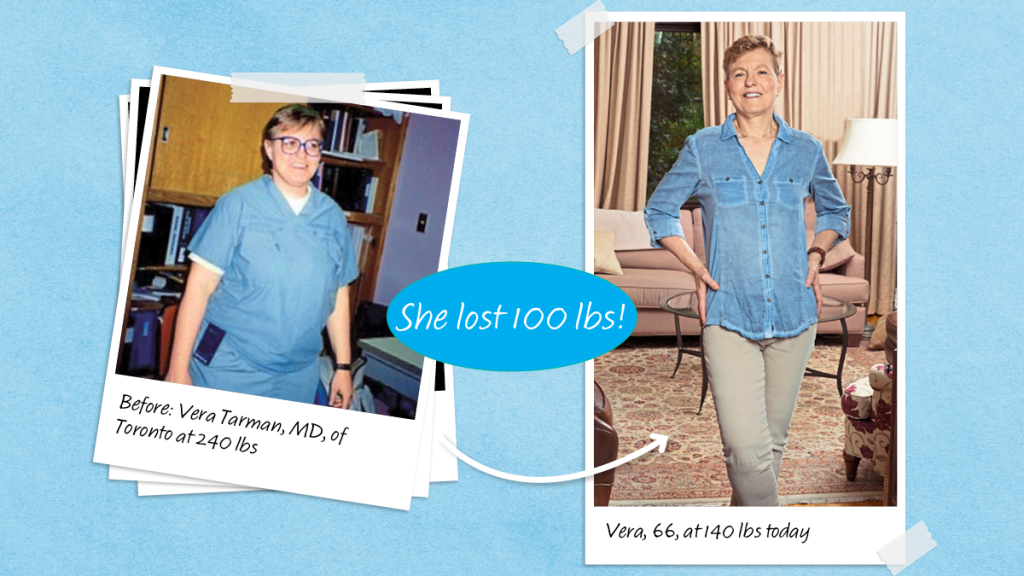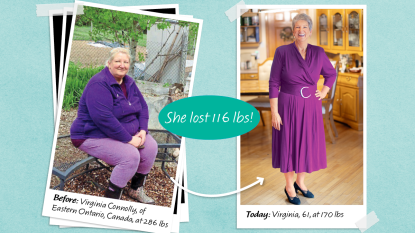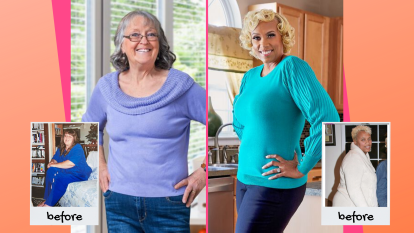Yes, You Can Quiet Food Noise — MD’s 3-Step Plan Works Naturally to End Overeating
Here's how to reduce mindless eating so you can lose weight without deprivation or struggle

Falling off the diet wagon might be the most important move we ever make on our lifelong journey to silence “food noise” and ultimately shed unwanted weight. For many of us, the constant voices in our head that urge us to overeat — what weight-loss experts now call food noise — seem too loud to silence. But the volume can be turned down or even off. Brown University’s Judson Brewer, MD, PhD, author of The Hunger Habit, says, “It’s scary because we’re so used to feeling like, if I don’t just control myself, I’m going to go off the rails. I say, go off the rails. But bring awareness to it, as compared to doing it in an automatic, mindless fashion.” Read on to learn exactly how to quiet food noise so you are in control of eating, not the other way around.
Food noise vs willpower
It’s common to beat ourselves up over our cravings, wishing we could just try harder to control things so we can function like everyone else. But it’s important to know: Willpower has nothing to do with overcoming the food noise that drives people to overeat. “Modern neuroscience really highlights how we need to end this debate. Willpower is not in the equations of behavior change,” reveals Dr. Brewer. “Willpower is more myth than muscle.” And he’s not alone. A growing mountain of research into food addiction and the new field of nutritional psychiatry takes willpower entirely off the table.
“When we have cravings, we’re operating from the middle, primitive, childlike part of our brain — the limbic system — and willpower doesn’t sit there,” says addiction expert Vera Tarman, MD. In fact, our brain can only use willpower for about 20 minutes a day before it hits what she calls frontal lobe fatigue. Dr. Tarman says, “Willpower is like an EpiPen you might use in an emergency to get through a dangerous moment. It buys you a minute to get out of trouble. But ultimately, you need to change your environment and get away from the ‘allergen’ causing your reaction — and it’s almost always sugar.”
What causes cravings
Dr. Brewer witnessed the limits of willpower in his own practice. As an addiction psychiatrist, he watched his patients struggle to deny their cravings for years. And when nothing else worked, he started giving them permission to fall off the wagon. He found that when people gave in to their cravings and really tuned into their feelings about it, the cravings — and the food noise behind them — lost their power. His research uncovered that it might take 10 or fewer tries, but then the perceived reward of eating a certain food diminishes so significantly, we’re able to turn our back on it and its calories. How can this be? Dr. Brewer explains the research is clear: Cravings, mindless eating and binge eating are all just learned habits that can be unlearned.
The key to overcoming food noise cravings is to get in touch with our true hunger. “Hunger can be colored, shaped, shifted, disguised and even merged with other cravings,” says Dr. Brewer. “For people who have ignored true physical hunger with dieting and restricting for a long time, this disconnect between brain and body can be especially significant.”
Simply put: “Hunger focuses on getting calories in and goes away when you eat anything. Craving is centered around the desire for something in particular,” he explains. When you have a craving for a donut, nothing else will satisfy you. It’s about recalibrating to know the difference between, “No wonder my stomach is rumbling, I need to eat lunch” versus the food noise telling us, “I must eat chocolate now!”
One way to tell if you’re truly hungry
To get in touch with your true hunger, try the classic Raisin Experiment, developed in the 1970s by Jon Kabat-Zinn, PhD, the father of mindfulness-based stress reduction programs.
To do: Hold a raisin. Imagine you don’t know what it is. View it from every angle. Explore it with your senses: How does it sound when you roll it in your palm? How does it smell? Feel? Bring it to your lips; observe what happens. Does your mouth water? Finally, slowly taste the raisin and see how you feel.
“Cravings originate in our thoughts. But our brains can’t feel hunger. Regaining body awareness lets us recognize our true hunger signals,” Dr. Brewer says. “When we use awareness around food we break the chain of automatic eating.”
It may help to pinpoint the source of your craving. When stress and emotion are driving cravings we can feel restless, tense, overwhelmed or have difficulty concentrating. If a simple habit is causing your cravings, you may just feel bored or are trying to procrastinate a task. And when true hunger is behind a craving, you can feel physical symptoms like headaches, moodiness, hangry feelings, dizzy/lightheadedness or a rumbling stomach.
The mindfulness trick that quiets food noise
Dr. Brewer’s approach to quieting cravings has been transformational for countless women — and their waistlines. In one study, overweight women who used his techniques reduced their craving-related eating by 40%, without relying on willpower. Dr. Brewer adds, “I’ve had several people report losing over 100 pounds and kept the weight off five years and counting.”
Dr. Brewer recalls a patient who was in the habit of eating an entire bag of potato chips each night. When she tuned into her body, she realized she only needed two chips to feel satisfied. He stresses, “Our feeling body is much stronger than our thinking brain. So reconnect with the body.” Psychologists call this reward-based learning. If something is rewarding, we keep doing it. If not, we’re going to stop. That breaks the habit loop.
Further proof: Laura Fenamore, a weight-release guide and author of Skinny, Fat, Perfect, lost 100 pounds when she adopted her own mindful eating practices. And keep scrolling to read Vera’s amazing weight-loss success story.
This approach may be particularly helpful to women whose food-noise cravings (and weight) spike due to hormonal changes at midlife. Dr. Brewer says, “The guidance is universal, so it can be used to work with physiologically induced or triggered urges both in perimenopause and menopause.” Plus, this wisdom can be applied to any diet or way of eating.
Related: Yoga for Menopause Helps Tame Hot Flashes, Irritability, Fatigue and More, Experts Agree
3 steps to end food noise naturally
How does Dr. Brewer’s plan work? Follow these 3 steps for 21 days to learn how to beat unhealthy eating and easily shed weight…
1. Recognize the habit
Think of an eating habit you’d like to change. Maybe it’s a food noise message that keeps repeating itself in your mind like: I have to stop at the fast food drive-thru on my way home from work. “It’s not a moral failing. It’s not a willpower failure. Accept that this behavior is just a habit loop you’re stuck in,” advises Dr. Brewer. In other words, our eating patterns are reinforced by repetition. “Our brains are predictive machines, and they’re going to choose future behavior based on past experience.” For example, if you always have a sweet snack before bed, you’ll likely keep doing it, whether you’re hungry or not.
2. Be curious, not critical
During this step, pause and investigate the food-noise habit without judgement. Ask yourself: What am I getting when I indulge in this food? “Think of curiosity as your superpower,” says Dr. Brewer. “If you don’t pay attention to the results of the behavior, you’re not going to change it.”
We’ve all experienced bloating, brain fog, pain and lethargy after overeating. But when we tune into these feelings, this is where “disenchantment” with a food habit comes. We are reminded that some foods aren’t as good as expected. “We are leveraging what the brain does best to help the brain change.” Dr. Brewer says, “It’s critical that people not skip this step, or they will revert back to unhealthy ways. His mantra: “Don’t think about it. Feel it in your body.”
3. Choose a new habit that nurtures you
Find something more rewarding. Dr. Brewer used this technique to overcome his addiction to gummy worm candies. He realized he didn’t enjoy the taste. So he replaced them with blueberries. He says, “Fresh blueberries are like playing a natural slot machine. You don’t know if it’s going to be slightly sweeter or slightly sour.”
Now Dr. Brewer admits, “It’s been years. You could put me in a bathtub full of gummy worms and I could swim my way out. There’s no willpower involved.” The food noise surrounding gummy worms was gone. He adds, “It’s not about telling ourselves blueberries are good for us. That’s our thinking brain where we get stuck. We’ve got to feel into our direct experience.”

Good news: You’ll notice food noise begin to fade fast
It’s important to note that cravings are temporary. Nina Savelle-Rocklin, PsyD, author of The Binge Cure, reminds, “A compulsion to eat is similar to a wave, in that we can ride it out.” And Dr. Brewer says in his research, the longest craving anyone ever reported lasted 12 minutes. On the flipside, mindful eating practices can work forever. Dr. Brewer says, “I see this in my patients. People are like, ‘I’ve tried everything. Nothing works. And oh my God, when I start paying attention, I can change.’”
5 bonus tips to try for yourself…
1. Eat when you’re truly hungry
Reach for whole, unprocessed foods, including lots of plants to quell hunger, boost mood and ease inflammation that triggers weight gain
2. Find your pleasure plateau
When you’re enjoying a treat, ask, “Is this more pleasurable, the same or less pleasurable than the last bite?” Dr. Brewer says, “With practice we learn when to take our foot off the gas so we coast to a stop rather than driving off the cliff of overindulgence.”
3. Consider nonfood fixes
When replacing old habits, remember the habits don’t have to be food-related. Perhaps you replace a mindless eating habit with taking a walk or catching up with a friend.
4. Tap into RAIN
When a craving strikes, use this acronym: Recognize, Accept, Investigate and Note. Dr. Brewer says. “It can change your brain and your life.” First, Recognize a craving and relax into it. Next, Allow and accept it without judgement. Investigate how the craving feels in your body. Lastly, Note what you learned. “The practice of noting our cravings allows us to manage them better,” says Dr. Brewer. “I have seen remarkable results from people using RAIN to curb their cravings.”
5. Savor self-love
Self-judgement and guilt about eating can be roadblocks for change. Savelle-Rocklin says, “There is nothing for you to forgive yourself for, and nothing more important than self-compassion.” In fact, a study found that those who handled a diet relapse with self-compassion were more likely to stick to their goals in the future. So proceed with kindness. If you’re having trouble being compassionate, start with being neutral. Think: “It is what it is.”
To learn more, read Dr. Brewer’s new book The Hunger Habit, or use his Eat Right Now app. And keep reading for Vera’s amazing 100-pound weight loss success story…
Food noise success story: Vera Tarman, 66

This isn’t a cane, it is just a walking stick, Vera Tarman told herself. But deep down, she couldn’t deny that she was having trouble walking her size 26 body up her hilly driveway without some support.
There were a lot of things about Vera’s weight she didn’t want to think about. As a doctor, she purposefully didn’t test herself for certain health conditions because she didn’t want to know the status, even though she saw the consequences of unhealthy diets in her patients daily. She believed she was supposed to be heavy. She blamed her “German genes” and “big bones.” But when she could no longer fit into her scrubs, it was time to question those old ideas. “I was asking my patients to lose weight without doing anything about my own situation.”
So Vera started experimenting
She knew she couldn’t get the results she wanted on a restrictive diet. Not while being addicted to sugar and flour. She agreed with what Judson Brewer, MD, PhD, said about willpower. “It’s the weakest link in our armor so I couldn’t count on it,” says Vera.
Instead, Vera focused on eating nutrient-rich whole foods that kept her feeling satisfied. She also tuned into her body sensations to determine real hunger from habitual snacking. She ate 4 oz. of healthy protein (like chicken and yogurt) at every meal and described her lifestyle as “keto lite.” By doing so, she says, “It kept away the hunger. I didn’t develop cravings.” She also avoided her drug of choice: sugar. She says, “It sounds like deprivation, but after a few weeks it’s not deprivation, it’s freedom!” (Click to learn more about a flexible keto plan.)
Vera lost around 30 pounds the first 3 months and about 5 pounds every additional month. “It was so encouraging. I just kept losing.” Her severe indigestion and constipation went away. She also noticed major improvements with her knee pain, plantar fasciitis and mood. She says, “My advice: Before you try antidepressants, do yourself a favor and eat more protein and fat and less sugar for a month.” As she shrunk to a size 10, she felt energized. “I went from huffing and puffing on stairs to running up them!”
Vera shed 100 pounds and become an addiction specialist
Vera shares, “I use mindfulness more now to stay clean, not get clean from food addiction.” She feels mindfulness practices can help most of the population with their unwanted cravings. But for more severe cases — maybe 15% to 20% of people with real food addiction — “behavioral techniques don’t work anymore. They’re not enough,” says the author of Food Junkies: Recovery from Food Addiction. They benefit from treatment or counseling from a medical professional.
Today, Vera is forever grateful to have healed her body. “My lab work is amazing now. My blood pressure is that of a premenopausal woman,” she raves. That’s not all: “Before, I felt like I was prematurely aging. Now I feel like I’ve gotten 10 years back from life!”













